




Hanwei lugu
Katana konstruktsioon
Hanwei mõõkade terastest
Katanade võrdlus
|
Monosteel Katana
Construction
|
| This is a quick
outline of the many steps involved in creating a high quality monosteel
(non-folded) Katana. |
Blade Construction:
|
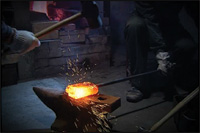 |
1. Rough Forging: The blade is
formed by hot forging a billet of
high-carbon steel. The repeated hammering provides an even dispersion
of carbon throughout the steel for uniform strength of the finished
blade. |
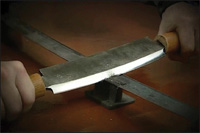 |
2. Rough Shaping: The scale is
removed and the blade is shaped roughly
to the required dimensions. At this stage, the steel is still in the
annealed (soft) state and the blade is straight. |
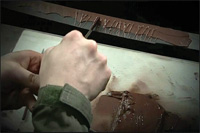 |
3. Clay Covering: A special
clay is applied to the blade by hand, using
a thin covering near the edge and a thicker layer over the rest of the
blade. This results in a relatively quicker cooling of the edge during
quenching, producing a hard edge and softer back. |
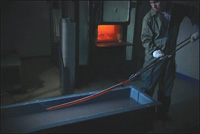 |
4. Quenching: This is a
critical part of the operation. The blade, with
its clay covering, is heated to a predetermined temperature and
quenched in a water bath. The shape and continuity of the hamon, the
sori (blade curvature), and blade straightness are all determined by
the care and skill exercised in quenching. |
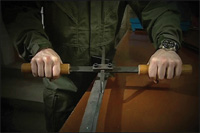 |
5. Sizing: The sori is
adjusted if necessary, to set the point of
balance and point of percussion, and the blade is de-scaled. Rough
polishing is carried out to size the blade accurately. The habaki
(blade collar) is fitted. |
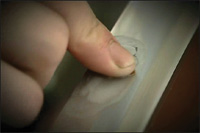 |
6. Finishing: Careful final
polishing and fine finish work are carried
out on the various surfaces to define ridgelines and bring out the
beauty of the hamon. |
Furniture Construction:
|
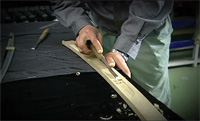 |
Saya: The saya is carved from
two pieces of wood to match the length,
width, thickness and curvature of the finished blade. The two halves
are then wrapped in cambric and lacquered numerous times. Final
polishing gives the saya finish a high gloss. |
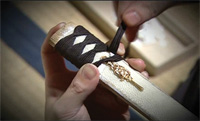 |
Tsuka: The handle core is
comprised of two pieces of hardwood carved to
tightly fit onto the tang. Channels are carved into the sides to
facilitate the fitting of two panels of ray skin. The entire handle is
then wrapped with high quality woven cotton or silk, depending on the
sword being fitted, while small paper triangles are used to help shape
the wrap correctly. The Menuki and Kashira are added during this
process. |
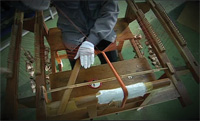 |
Sageo: The sageo is typically
woven of high quality cotton or silk to
match the handle wrap. In some cases, the sageo is still woven by hand
(see Paper Crane). This process requires many hours of skilled hand
labor but allows thematic designs to be worked into the sageo. |
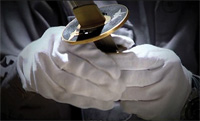 |
Assembly: Finally all the
pieces can be assembled and the handle
securely fastened to the tang. This is accomplished by drilling the
handle and the tang together in two places and inserting bamboo pegs
(mekugi) to pin the handle to the tang. |
The Parts of a Katana:
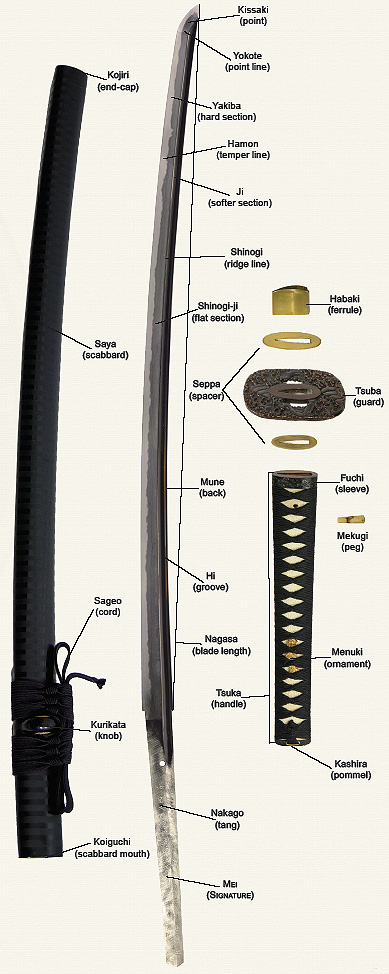 |
Performance Series Katana
Our Performance Series Katana are the culmination of years of study,
trial, and error into the optimum blade designs for today’s martial
artists. Four distinct variations are available, each optimized for a
particular discipline or cutting application. The Iaito is an unedged
training blade, available in three different lengths, for use in
drawing practice and Kata. Its correctly-weighted and balanced steel
blade prepares the student for advanced work with live blades. The
blade geometry and physical characteristics of each of the Tameshigiri
(cutting practice) blades are tailored towards different targets. The
Elite Katana’s blade is a little wider and a little thicker than its
traditional counterpart, allowing for easier cuts on normal targets,
while that of the Katana XL is significantly wider , for use in cutting
heavy targets. The Katana XL Light has the XL’s profile but is provided
with Bo-hi, reducing the weight to the point where double cuts are
possible but clean cuts on heavier targets may still be made.
|
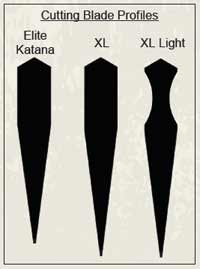 |
|
 |
Iaito: Frequent
Drawing Practice
-
These unedged training blades provide for safe drawing for the
beginning practitioner of the 450 year old art of Iaido. Forged from
stainless steel the tempered blades are not only maintenance-free but
more importantly provide the correct weight and balance needed for the
rigors of repetitve drawing and sword motion practice. Each blade has a
deeply cut groove (bo-hi) to provide audible feedback when swung
properly.
|
 |
Elite Katana: Frequent
Cutting / Advanced Drawing Practice
-
Our Katana Blades embody the classical design elements of the most
prolific sword design in history. With their strong Shinogi Zukuri
shape that accentuates the differential heat treatment, these blades
are traditionally proportioned to appeal to the collector but they will
also perform well in general cutting of hard or soft targets.
|
 |
XL: Heavy
Competitive Cutting
-
Designed strictly for competitive cutting, our XL Katana blades
incorporate the geometry, strength, weight and profile needed for
successful cuts on substantial targets. Featuring differential heat
treatment and a narrow edge angle, these wide blades will reward good
technique with clean cuts and excellent durability.
|
 |
XL Light: Competitive
Cutting / Light Weight
-
The XL Light blades feature the same geometry as those of the XL but
incorporate deeply cut grooves (bo-hi) to reduce the weight of the
blade while retaining most of it’s strength and cutting ability. This
weight reduction makes for a quicker sword, well adapted for multiple
cuts in lighter targets. |
|
|







